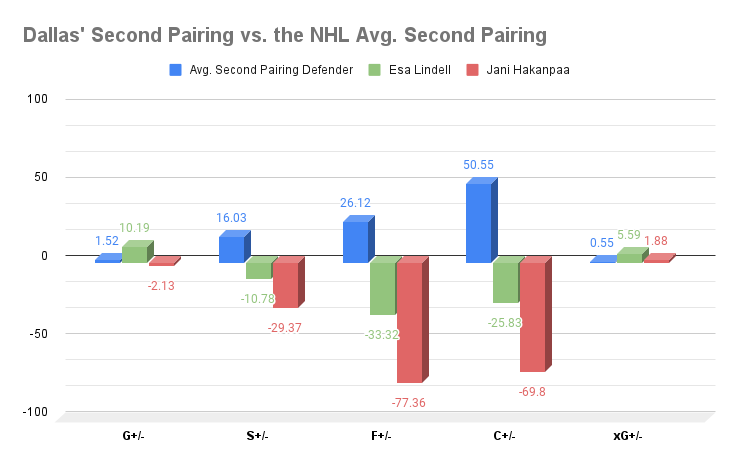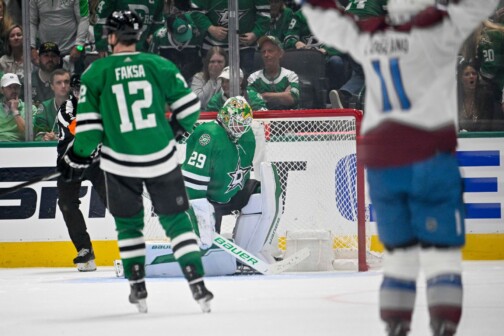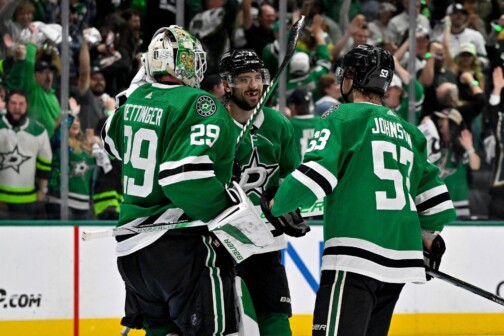Defensemen in the modern NHL have evolved to do more than just block shots and clear the crease. As the game gets faster, so does the modern defender’s ability to move—and think—fast. You can’t get by operating effectively in just one zone; you have to operate effectively in all three. This added dimension is why scoring is up. Teams are averaging three goals a game, hockey’s highest number since 1995. Goal scoring for defensemen has gone up 23 percent, and their assist rates have climbed even higher. The gap between forward versus defender shooting contributions have closed considerably. So why is the antithesis to all of the above, the pairing of Esa Lindell and Jani Hakanpaa, a thing?
Where the modern defender has progressed to move quickly out of his own zone, the Stars’ second pairing doesn’t move out of its own zone at all. While the modern defender can make plays to shorten the neutral zone and keep opponents hemmed in, Lindell and Hakanpaa remain nonfactors in transition. Defensemen are now encouraged to contribute to team shooting and passing. Lindell and Hakanpaa are capable of neither. Regardless of where they fit into the current spectrum of defensemen, they’re Miro Heiskanen’s primary sidekicks for the foreseeable future.
It’s important to keep in mind that the problem is not necessarily Lindell and Hakanpaa on their own, but Lindell and Hakanpaa together. After all, both have played effectively in specific roles, whether it’s Lindell in a supporting presence next to a more modern defender or Hakanpaa pulling depth duty on the bottom pair. We can skip the obvious criticism of the duo; namely, that they’re not very good offensively. That’s not what stands out.
What stands out is that many teams have a number one defender playing on its second pair.
In Buffalo, Owen Power plays on the second pair with Henri Jokiharju, but is runner-up only to Rasmus Dahlin in minutes played. In Las Vegas, Shea Theodore plays on the second pairing with Brayden McNabb, but is behind only Alex Pietrangelo in ice time. Victor Hedman might get top billing in Tampa, but Mikhail Sergachev is the Lightning’s minutes leader. Last season, Florida was the most extreme example, with Brandon Montour—a career depth defender—eating even more minutes per game than Aaron Ekblad.
Given how much Lindell and Hakanpaa stand out as an outdated grouping, I wondered if this was also reflected in their performance. How do they compare to the average second pair?
Below is a straightforward chart. It’s the even-strength plus-minus of Lindell (green) and Hakanpaa (red) in terms of goals, shots on goal, unblocked shot attempts, shot attempts, and shot quality compared to the average second-pairing defender (blue). It’s not pretty.
Dallas’ second pair gets hammered in terms of possession. It’s technically not all bad; Lindell, in particular, has a strong impact on goals, while both positively affect the bottom line in terms of shot quality. However, the drop-off is so severe everywhere else that it’s hard to imagine this isn’t seriously affecting the Stars’ ability to play a more territorial game.
I know the common refrain: “But they play tough competition.” Is there another second pairing that doesn’t play tough competition? It’s true that Lindell and Hakanpaa have it a little tougher than most. They start in the offensive zone on less than 5 percent of their shifts, which ranks 66th and 69th of 70 among their peers. However, they also have it better than most. While the average d-man in a supporting role starts 62 percent of his shifts on the fly, Lindell and Hakanpaa started 68 and 70 percent of their shifts on the fly— meaning they’re more in control of the situation. Beyond that, in terms of shot attempts versus elite competition, Dallas performs better without them. So while they have their strengths, their weaknesses heavily contribute to the Stars’ inability to gain territory.
There’s nothing abstract about the concept of territory. For the 19 minutes a game that Lindell and Hakanpaa are on the ice, that’s 19 minutes in which the team struggles to exit the zone with possession, thereby hindering the team’s ability to break into the opposing zone with control, thus decreasing the chance of Dallas generating chances. Modern hockey is a transition game, and neither player is terribly suited for it.
I don’t believe their presence is Pete DeBoer’s act of protest, though. At the start of last year, Lindell was paired with Nils Lundkvist, while Ryan Suter played with Hakanpaa. With Lundkvist struggling to mature as Dallas would have hoped, DeBoer was “forced” into constructing a second pair that, though lacking in strengths, at least didn’t have any glaring weaknesses. Lindell and Hakanpaa may not have been able to facilitate the puck to their forwards, but at least they didn’t facilitate it to their opponents.
Still, DeBoer has talked openly about attacking more off the rush, something he also stressed in San Jose and Las Vegas. I doubt Lindell and Hakanpaa, who clearly limit the Stars’ ability to do that, reflect what DeBoer truly wants. He can only work with the tools he has. But it’s also worth remembering the duo was a product of a pre-Thomas Harley world. I don’t think there’s any reason to question where Harley fits into the blueline. Dallas will monitor Harley closely, but I’d imagine his breakthrough performance in the 2023 playoffs was more than enough to give him the necessary leash. A leash for what, though?
Harley could get a shot with Hakanpaa. While they only have preseason experience together, it makes sense on paper: Harley moves the puck, and Hakanpaa stops it. There’s symmetry more than chemistry, but at least the forwards would have somebody on the second pair to move the puck from the backend. If this means Lindell with Lundkvist, that’s not a bad start. The two played 90 minutes together last season, posting a staggering 54 percent control of shot quality. (This would have led all Dallas defenders in share of shot quality had they maintained that pace.) I don’t see any other solution unless DeBoer is comfortable putting Harley with Lundkvist, which is doubtful given any coach’s reticence to pair two puck movers.
Of course, Dallas also could keep its safety net. Maybe it works out. The Stars were third in expected goals-against per hour, after all. That’s extremely impressive, and a testament to Lindell and Hakanpaa. However, nobody ever mentions another stat: The Stars were only 16th in expected goals-for at even strength—an area that hurt them in the long run as they struggled to win the territorial battle versus Vegas. That’s less impressive, and also a testament to Lindell and Hakanpaa. Neither player can change who he is at this point in his career, but their head coach can change their roles. Perhaps that’s all the Stars need.
Author








